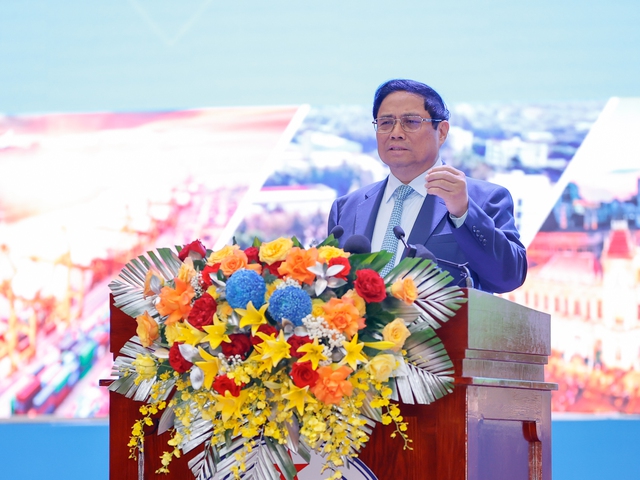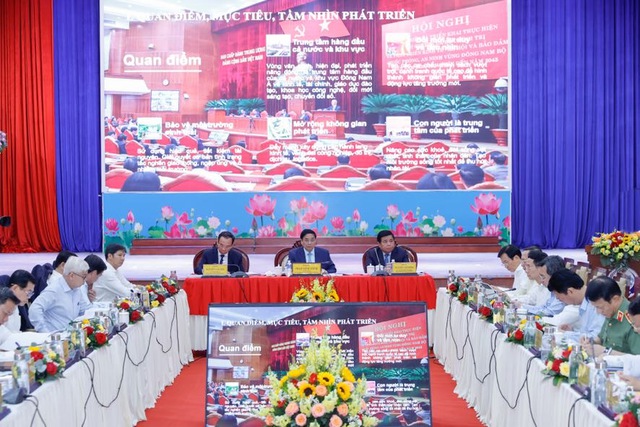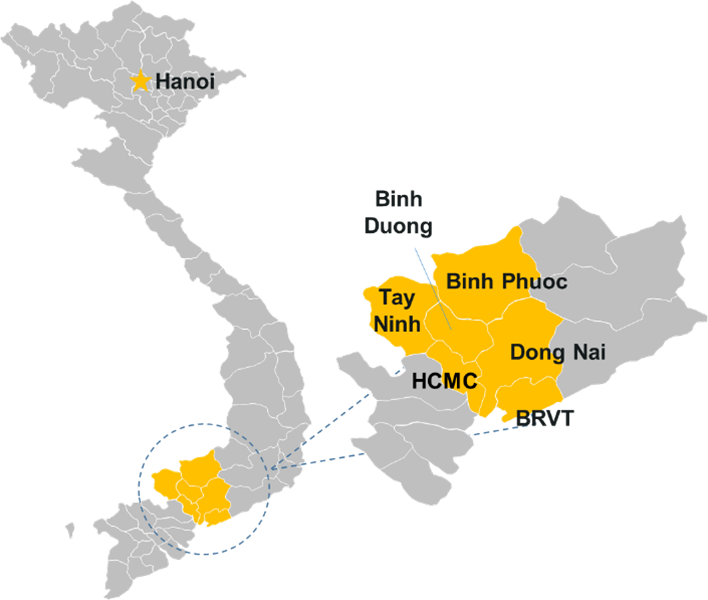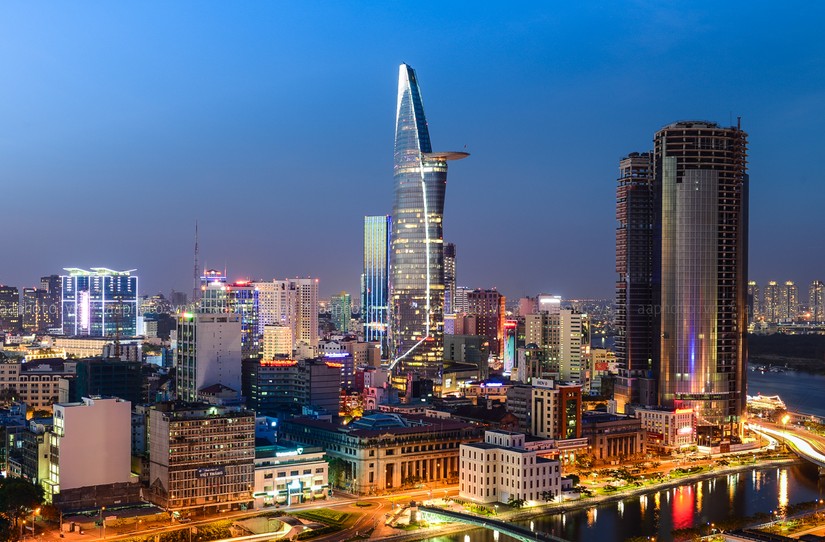Vietnam's Southeast region, a dynamic economic nexus often hailed as the "City of the Fatherland," is embarking on an ambitious quest to solidify its position as a preeminent growth engine for the nation.
At the core of this endeavor lies a carefully orchestrated regional development plan, approved on May 4 by Prime Minister Pham Minh Chinh, aimed at capitalizing on the region's unique potential and competitive strengths.
Formidable Economic Prowess
Defying its modest geographical footprint, which encompasses a mere 7.1% of the nation's population and 18.9% of its land area, the Southeast region's economic clout is undeniable.
In 2023, its Gross Regional Domestic Product (GRDP) growth rate of 5.06% surpassed the national average of 5.05%, a testament to its resilience amid global headwinds. Remarkably, the region's GRDP contribution accounts for a staggering 30.2% of Vietnam's overall GDP, solidifying its status as a critical economic fulcrum.
Beyond topline figures, the Southeast's economic preeminence is further underscored by its impressive per capita GRDP of VND 166 million (USD 6,561), one of the highest living standards nationwide, eclipsing the domestic average.
Furthermore, the region's fiscal prowess is exemplified by its substantial state budget revenue of VND 689.7 trillion (USD 27.3 billion), constituting a formidable 36.2% of the national total, highlighting its pivotal role in fueling the country's economic engine.
Powering the region's economic dynamism are its robust export and foreign direct investment (FDI) performances. In 2023, the Southeast accounted for a commanding 31.4% of the country's total exports, valued at a staggering VND 112.7 trillion (USD 4.45 billion).
This export prowess is complemented by an equally impressive FDI attraction record, with the region securing USD 11.39 billion in foreign investment, representing 31.1% of the national total, underscoring its allure as an investment destination.

Catalyzing Connectivity through Infrastructure
At the heart of the region's development blueprint lies an unwavering commitment to infrastructure investment, a catalyst for seamless connectivity and unlocking new economic frontiers.
Flagship projects, such as the Ring Road 3 in Ho Chi Minh City, the expansion of Tan Son Nhat International Airport, and the ambitious Long Thanh International Airport Phase 1, are progressing steadily, poised to alleviate transportation bottlenecks and enhance regional accessibility.
The Ring Road 3 project, a vital artery encircling Ho Chi Minh City, has already commenced construction, with various sections progressing at varying paces. The Long An province segment has achieved over 22% completion, while the Ho Chi Minh City portion stands at 12.5%.
The Binh Duong and Dong Nai province sections have attained 9% and 2% completion, respectively. This strategic infrastructure endeavor aims to alleviate traffic congestion and facilitate the efficient movement of goods and people within the region.
Complementing the road network upgrades, the expansion of Tan Son Nhat International Airport is well underway, with the construction of the new Passenger Terminal T3 surpassing the 50% mark for rough construction.
This multi-billion-dollar strategic investment is poised to augment the airport's capacity and elevate the travel experience for the region's burgeoning passenger traffic, which has been witnessing a steady upward trajectory in recent years.
The Ben Luc-Long Thanh expressway project, another critical transportation link, is also under active development, with the total volume of the bidding package currently standing at approximately 80.05%.
Upon completion, this expressway will forge a seamless connection between Long Thanh International Airport and the region's urban hubs, further bolstering the area's accessibility and economic competitiveness.
Transcending conventional infrastructure, the plan envisions the establishment of a world-class International Financial Center in Ho Chi Minh City and a strategic Can Gio International Transshipment Port, positioning the region as a global nexus for finance and logistics.
The Can Gio project, in particular, has garnered significant attention, with the investor poised to dispatch a delegation in May to finalize joint venture arrangements, underscoring the project's momentum.

Turbo-Charging Strategic Initiatives
Recognizing the urgency of expediting critical infrastructure initiatives, Prime Minister Pham Minh Chinh has issued directives to accelerate progress on key projects.
The Ho Chi Minh City-Moc Bai expressway, a vital artery linking the region to neighboring Cambodia, is slated for completion of its pre-feasibility study by May 15, paving the way for the project's implementation.
Similarly, the Gia Nghia (Dak Nong)-Chon Thanh (Binh Phuoc) expressway, a pivotal inter-provincial corridor, has garnered the Prime Minister's endorsement, with the pre-feasibility study report already submitted to the National Assembly for consideration during its 7th session.
This strategic artery is expected to foster greater economic integration and mobility within the region.
In addition to these major expressway initiatives, the Prime Minister has mandated the acceleration of several other projects, including the Ho Chi Minh City-Chon Thanh expressway, the Dau Giay-Lien Khuong expressway, and the Chon Thanh-Duc Hoa expressway.
Collectively, these infrastructure enhancements will form a robust transportation network, facilitating the seamless movement of goods and people across the region.
Furthermore, the Prime Minister has set ambitious targets for the completion of several flagship projects, including the Long Thanh International Airport, which is slated for substantial completion in 2025.
The inauguration of the Passenger Terminal T3 at Tan Son Nhat International Airport has also been scheduled for April 30, 2025, underscoring the government's commitment to enhancing the region's air connectivity.
Reinvigorating Economic Sectors
Parallel to infrastructure upgrades, the plan emphasizes restructuring economic sectors to align with modern trends and capitalize on the region's inherent strengths.
The development of high-value service industries, such as e-commerce, regional logistics centers, and the burgeoning Ho Chi Minh City International Financial Center, is a strategic imperative.
The Ho Chi Minh City International Financial Center, in particular, has garnered significant attention, with the government recognizing its potential to position the region as a global financial hub.
Deputy Prime Minister Le Minh Khai has been entrusted with overseeing this ambitious endeavor, ensuring that the necessary legal and regulatory frameworks are in place to facilitate its development.
The establishment of a robust financial center is expected to attract an influx of investment, foster innovation, and solidify the region's status as a leading economic powerhouse.
Moreover, the plan aims to nurture innovation and leverage scientific advancements to propel the region's industrial sectors. By fostering entrepreneurship and embracing cutting-edge technologies, the region seeks to cement its position as a hub for knowledge-based industries and foster sustainable, long-term growth.
The Ministry of Science and Technology, helmed by Minister Huynh Thanh Dat, is actively engaged in this effort, advocating for increased investment in research and development, and promoting public-private partnerships to accelerate the commercialization of innovative technologies.
Furthermore, the development of robust industrial parks, economic zones, and seaports is a key focus area for the region.
These specialized zones will serve as catalysts for industrial growth, attracting both domestic and foreign investments, while fostering a conducive environment for businesses to thrive.
The Ministry of Planning and Investment has been entrusted with reviewing and streamlining policies related to these zones, ensuring an investor-friendly regulatory landscape that promotes sustainable and responsible economic development.

Cultivating Talent and Championing Environmental Stewardship
Acknowledging the pivotal role of human capital in driving economic progress, the plan underscores the importance of talent cultivation and the development of a skilled workforce.
Initiatives focused on training high-quality human resources, attracting top talent, and promoting innovation and creativity are central to the region's aspirations.
The semiconductor industry has been identified as a priority sector, with the region seeking to nurture a pipeline of skilled professionals to support its growth. This strategic focus aligns with Vietnam's broader ambitions to establish itself as a regional hub for semiconductor manufacturing and research.
To this end, the government is exploring partnerships with leading universities and research institutions, both domestically and internationally, to develop specialized curricula and training programs that cater to the industry's unique needs.
These collaborations aim to create a talent pipeline capable of driving innovation and propelling the region's semiconductor aspirations.
Complementing economic ambitions, the plan acknowledges the imperative of environmental stewardship and social development.
Investments in flood prevention projects, upgrades to irrigation systems, and measures to enhance urban livability are integral components, ensuring that growth is sustainable and equitable.
Ho Chi Minh City, the region's economic powerhouse, has been at the forefront of addressing urban challenges.
The city's Chairman, Phan Van Mai, has underscored the pressing need for flood prevention projects, highlighting the region's commitment to climate resilience and safeguarding its residents from the impacts of extreme weather events.
Similar initiatives are expected to be rolled out across the region, ensuring that infrastructure development is accompanied by robust measures to mitigate environmental risks and protect vulnerable communities.
Fostering Regional Cohesion and Synergy
A cornerstone of the plan is the promotion of regional coordination and collaboration, fostering synergies among the six provinces and cities that comprise the Southeast region: Ho Chi Minh City, Ba Ria-Vung Tau, Binh Duong, Binh Phuoc, Dong Nai, and Tay Ninh.
By aligning development strategies, sharing resources, and embracing a unified vision, the region aims to amplify its collective strengths and overcome shared challenges more effectively.
To facilitate this cooperation, the government has established the Southeast Regional Coordinating Council, a dedicated platform for strategic planning, policy harmonization, and inter-provincial linkages.
This institutional framework aims to streamline decision-making processes and ensure cohesive implementation of the region's development agenda.
The Council, chaired by Prime Minister Pham Minh Chinh himself, has already convened three meetings, addressing pertinent topics and setting the stage for enhanced regional collaboration.
Notably, the Council has made significant strides in addressing institutional barriers, completing its operating regulations and laying the groundwork for effective coordination mechanisms.
Complementing the Council's efforts, the government has taken concrete steps to establish a robust legal foundation for the region's development. Resolution No. 98/2023/QH15, promulgated by the National Assembly, introduces specific mechanisms and policies tailored for Ho Chi Minh City's development, including groundbreaking initiatives to facilitate the city's growth.
This resolution paves the way for the implementation of innovative strategies and policies that cater to the unique needs and challenges of the region's economic epicenter.

Heralding a New Era of Collaboration and Innovation
Prime Minister Pham Minh Chinh has outlined a clear roadmap for the region's transformation, emphasizing five "keyword" phrases: "acceleration, breakthrough, pioneering, close connection, and substance and effectiveness."
This mantra encapsulates the urgency, ingenuity, and pragmatism required to propel the Southeast region to new heights.
By fostering an environment conducive to innovation, embracing public-private partnerships, and mobilizing resources from diverse sources, the region aims to unlock its full potential.
The plan's emphasis on smart management, open and modern mechanisms, and the application of science and technology underscores the government's commitment to adopting cutting-edge practices.
To this end, the Ministry of Planning and Investment has been tasked with coordinating a comprehensive review of specific mechanisms and policies across five key domains: transport infrastructure investment and resource mobilization, science and technology, industrial parks and economic zones, human resource development, and land and construction.
This initiative aims to streamline regulations, incentivize private sector participation, and ensure the effective allocation of resources to drive the region's transformation.
Furthermore, the plan advocates for a departure from traditional growth drivers, such as investment, exports, and consumption, and a concerted effort to nurture new engines of growth.
The digital economy, green economy, circular economy, sharing economy, and knowledge economy have been identified as strategic priorities, reflecting the region's commitment to embracing disruptive technologies and sustainable practices.
Regional coordination and cooperation underpin this ambitious agenda, with the plan emphasizing the importance of leveraging the collective strengths of the region's diverse stakeholders.
The private sector, in particular, is poised to play a pivotal role, with the government actively seeking to unlock private investment and foster public-private partnerships through incentives and supportive policies.
Overcoming Challenges and Seizing Opportunities
Despite the region's remarkable achievements and promising prospects, challenges remain, including limited inter-regional connectivity, underutilized scientific and technological potential, and lingering environmental issues such as pollution, traffic congestion, and urban flooding.
Moreover, the transformation of the growth model to achieve rapid and sustainable development has progressed more slowly than desired in certain sectors.
However, the architects of the regional development plan are acutely aware of these hurdles and have embedded strategies to address them head-on.
The plan's emphasis on strategic infrastructure investments, such as the proposed high-speed rail network connecting major urban centers and upgrades to road and aviation infrastructure, aims to enhance inter-regional mobility and facilitate the seamless movement of goods and services.
Furthermore, the plan's emphasis on science, technology, and innovation, coupled with initiatives to attract and cultivate top talent, is poised to unlock the region's full potential in these critical domains.
By fostering a conducive environment for research and development, promoting collaboration between academic institutions and the private sector, and incentivizing innovation through supportive policies, the region can position itself at the forefront of emerging technologies and drive innovation-led growth.
Environmental sustainability is also a central tenet of the plan, with measures aimed at mitigating pollution, implementing flood control measures, and promoting green practices across various sectors.
The integration of environmental considerations into the region's development trajectory reflects a holistic approach to growth, ensuring that economic prosperity is not achieved at the expense of ecological well-being.
Initiatives such as investment in flood prevention infrastructure, upgrades to irrigation systems, and the promotion of sustainable urban development practices are expected to play a crucial role in safeguarding the region's natural resources and enhancing its resilience to climate change.
As the Southeast region embarks on this ambitious journey, the nation's collective gaze is fixed on this economic powerhouse, eager to witness its transformation into a true "City of the Fatherland" – a beacon of progress, prosperity, and regional cooperation.
With a well-crafted plan, unwavering leadership, and a commitment to innovation and collaboration, the region is poised to transcend its challenges and seize the opportunities that lie ahead, cementing its position as a driving force in Vietnam's continued economic ascent on the global stage.









 Google translate
Google translate